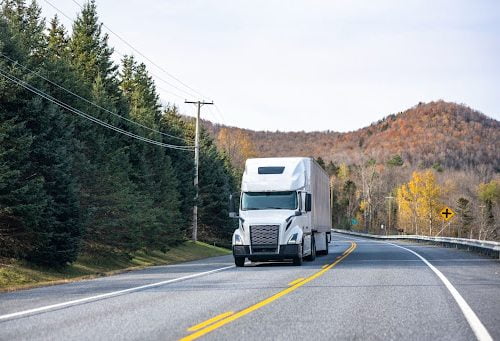Standard Safe-Driving Practices
Basic safe driving habits form the foundation of road safety. Wear a seatbelt, don’t text and drive, and obey the speed limit. These practices are particularly important as the risk of accidents with big trucks is higher due to the size and weight of these vehicles.
Follow the Speed Limit
Adhering to speed limits can help keep you and others safe, especially near big trucks. In Massachusetts, laws such as MGL c.90, § 17 dictate speed limits tailored for different road types and conditions. These limits are set not only for your safety but also to accommodate the varied capabilities of different vehicles sharing the road.
For instance, big trucks take longer to stop than cars, so if you’re driving too fast, you reduce your own reaction time and the truck driver’s ability to react to your actions. This is particularly important in traffic, construction zones, and heavily populated areas where trucks may need to make sudden stops or slow down unexpectedly.
Keeping to the speed limit gives you more time to react to the truck’s movements and adjust your driving accordingly.
Wear a Seatbelt
Wearing a seatbelt is required by law in Massachusetts. In the event of an accident, a seatbelt can significantly reduce the risk of severe injury or death. This is especially true in incidents involving large trucks, where the force of impact can be much greater due to the size and weight of these vehicles.
Drive Alert
Staying alert is imperative when driving, particularly near big trucks. Massachusetts laws strictly enforce rules against drunk, drowsy, or distracted driving. Being fully alert is vital near large vehicles like 18-wheelers, where reaction times can be the difference between a close call and a collision. Alcohol, fatigue, and distractions like texting significantly impair your ability to react quickly and make sound judgments. This is even more important in the vicinity of big trucks, which have longer stopping distances and limited maneuverability.
18-Wheelers Pose Unique Risks
The size and weight of 18-wheelers contribute to specific hazards on the road. These trucks have longer stopping distances, wider turning radii, and significant blind spots. Given their size, even minor mistakes or misjudgments in proximity to these trucks can have serious consequences.

Pass Big Trucks Safely
Passing large trucks requires careful consideration. Always avoid passing on the right side where the blind spot is larger. Use appropriate signals well in advance to alert the truck driver of your intention. Ensure you can see the truck’s mirrors before passing – if you can’t see the driver, they can’t see you. After passing, give yourself enough room before merging back in front of the truck. Cutting too close can be dangerous, as trucks require more distance to slow down or stop.
Look Out for Wide Turns
Trucks make wide turns, especially in urban areas where streets are narrower. Be cautious of trucks at intersections and give them extra space to maneuver. Avoid squeezing in between the truck and the curb, as the truck may swing wide. Paying attention to a truck’s turn signals can provide valuable cues about its next move, allowing you to keep a safe distance.
Don’t Rush a Turn
When turning, merging, or changing lanes near a truck, take extra time. Ensure the truck driver has seen your signal and provided sufficient space before you move in front of them. Rushing these maneuvers can lead to dangerous situations, especially since trucks cannot stop as swiftly as smaller vehicles. Patience and caution are key when sharing the road with big trucks.
Give Tractor-Trailers Their Space
Maintain a safe following distance behind trucks. Avoid tailgating or cutting off trucks, as their longer stopping distances mean they can’t stop quickly to avoid a collision. Keep in mind that if you’re too close to a truck, you’re likely in a blind spot and the driver may not be aware of your presence.
Avoid the Four Blind Spots
Be mindful of the four main blind spots around trucks – directly in front, behind, and on both sides. Staying out of these zones ensures the truck driver can see you. If you need to pass a truck, do it quickly and safely to minimize the time spent in these blind spots. Further details on navigating around these blind spots are available in our related blog.
Beyond Defensive Driving: The Importance of Legal Protection
Even with cautious driving, accidents involving trucks can still occur. Jim Glaser Law understands Massachusetts and federal trucking laws and can guide you through the legal process if you’ve been injured by a negligent truck driver. We are dedicated to providing the support you need and helping you secure the compensation you deserve.
Related Articles & Info
- The Most Common Truck Accident Causes in Massachusetts
- How Fault Is Determined in a Commercial Truck Accident
- What You Need To Know About Massachusetts Trucking Laws
- Understanding Blind Spots on Tractor-Trailers
- How Fault Is Determined in a Semi-Truck Accident in Massachusetts
- Who Is Responsible When Brake Failure Causes a Semi-Truck Accident?
- Why You Need a Boston Attorney After a Semi-Truck Accident














